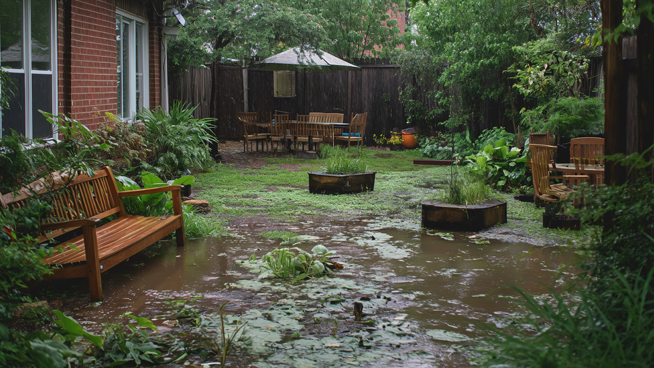
From The Detroit News | By Ken Calverley and Chuck Breidenstein
DETROIT, April 4, 2024 ~ With the arrival of spring rains, the Inside Outside Guys are anticipating an increase in questions about water mitigation for flooded yards in southeast Michigan.
Many communities in this region were built on former swamplands, resulting in damp ground that can cause problems for homeowners.
If your neighbors’ yards are higher than yours, you likely have an unwelcome pond in your backyard for at least a few months of the year. This can have a negative impact on your foundation and may cause your sump pump to work harder.
PODCAST:
April 7, 2024 ~ Chuck “The Inside Guy” Breidenstein and Ken “The Outside Guy” Calverly offer the knowledge and resources you need to make the home of your dreams a reality.
(CONTINUED)
You might also have a breeding ground for mosquitoes or, even worse, the water finds its way into your crawlspace or basement.
For many homeowners, it’s not possible to rely on gravity alone to remove the water from their property, especially if the water level in their backyard is level with, or even lower than, the street.
So, what can you do in such a situation? If this describes your yard, we’ll provide you with a couple of options to help you start drying out your lot when the rains begin.
One choice is to build up the soils around your home. Consider the amount of dirt it would take to raise the property high enough to drain. Additionally, think about whether a truck can access your lot or if you’ll need to find another way to transport the dirt to your backyard.
Consider whether building up the surrounding grade would place the soil around your home too close to the bottom of the siding.
This option is often not practical for many homeowners, so let’s consider something else.
One possible solution is a French drain. The idea is to create a basin beneath the lawn that can collect and retain surface waters and slowly allow them to dissipate into the soils.
Before you install a subsurface water detention area, it’s important to have a clear understanding of your property lines, any permits that might be required, and to contact Miss Dig at 811 to ensure the location of underground utilities.
Start by estimating the volume of water you wish to drain out of your yard, then sketch out a design of trenches that will lead to the desired water collection area.
Dig a hole in your lot that is large enough to accommodate one or several perforated 55-gallon drums, depending on the anticipated volume.
This may be located in a back corner of your lot.
Line the hole with landscape, filter, cloth and cover the bottom with 6 inches of stone or pea gravel. Place the drum(s) upright in the hole and wrap with landscape cloth. Fill both the drum(s) and the surrounding area with stone.
Next, dig trenches just below the sod in a radiating pattern away from the collection spot. Lay 4-inch black, corrugated and cloth-wrapped pipe in the trenches. The pipe should be gently sloped toward the collection area.
Finally, cut and install the remaining drainage cloth on top of the pipe and stone that is a couple inches below the grass in both the trenches and collection area. Cover the cloth with topsoil and seed.
If a drainage area is not possible, homeowners may need to consider having a sump crock installed in their backyard. This allows for the mechanical removal of water with the help of a pump and a garden hose, possibly carrying the water to the drive and a curb-side gutter.
These methods can effectively address water issues in your yard and prevent further damage to your property. If you need help from a professional, contact Just Ask Home Maintenance, which has a division dedicated to residential water management at LetJustAsk.com.
For all your housing and professional contractor needs, visit the InsideOutsideGuys.com.
**
For more advice, listen to “The Inside Outside Guys” every Saturday and Sunday on 760 WJR from 10 a.m. to noon or contact them at InsideOutsideGuys.com.
96.3 WDVD TOP STORIES:








